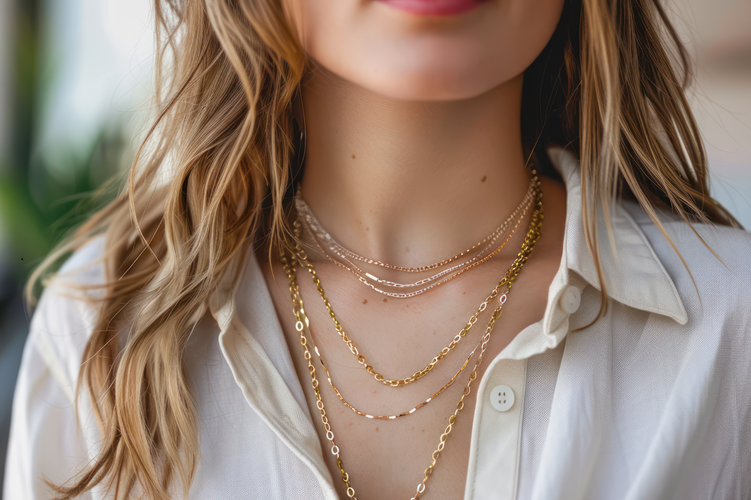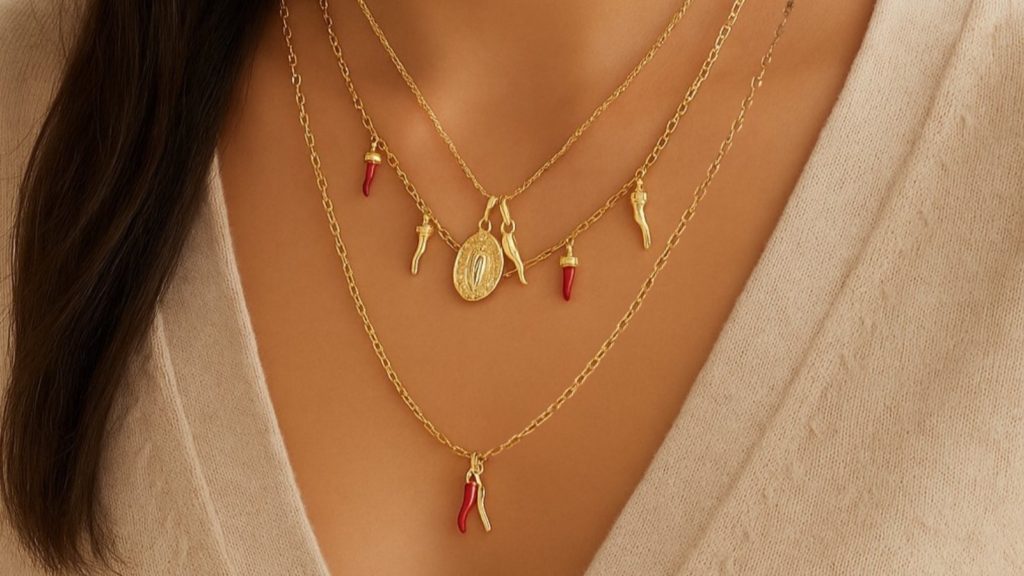Introduction
Layering Necklaces has become one of the most stylish and versatile jewellery trends of the decade. Whether you want to add dimension to your everyday outfit or elevate your evening look, learning how to layer necklaces like a pro can completely transform your accessory game. The key lies in balance, texture, and thoughtful curation—not just piling on chains at random.
In this step-by-step guide, we’ll show you how to create perfectly layered looks that feel effortless and sophisticated, not cluttered or chaotic.
Step-by-Step Guide to Perfectly Layered Necklaces

Step 1: Understand the Art Behind Necklace Layering
Before you reach for your jewellery box, it’s important to understand that layering necklaces isn’t just about piling on random pieces. It’s about creating a cohesive visual flow from your neckline downward. Think of it as building an outfit—but for your collarbone.
Layering lets you play with dimension, contrast, and texture. A well-layered look adds depth and interest, guiding the eye naturally from piece to piece. Done wrong, it can feel cluttered or tangled. Done right, it can instantly polish your look, whether you’re wearing a casual tee or an elegant dress.
Step 2: Choose a Focal Point Necklace
The first and most essential step is to choose a central or “anchor” necklace—a piece that you want to highlight as the star of your stack. This could be:
- A meaningful pendant (e.g., initials, birthstone, or religious symbol)
- A bold medallion or coin necklace
- A gemstone centerpiece
- A bar or nameplate necklace
Your focal necklace usually sits at a medium length (16–18 inches), right near the center of your chest. Everything else in your layered look will be styled around this piece, so pick something you want to draw attention to.
Why this matters:
A focal point keeps the look intentional. Without one, the layers can compete rather than complement. Choose something with personal meaning or a standout aesthetic—it becomes the soul of your stack.
Step 3: Vary the Lengths Strategically
The most important principle of necklace layering is length variation. This keeps each necklace visible and prevents them from bunching together.
Here’s a classic guide to lengths:
- Choker (14–15 inches) – Sits snugly at the base of the neck
- Princess length (16–18 inches) – Common pendant length; great for focal pieces
- Matinee (20–24 inches) – Perfect for deeper necklines or base layers
- Opera (28–36 inches) – Dramatic and perfect for elongating the look
How to do it:
Try combining three necklaces with at least 2–3 inches between them. This gives each one room to shine without overlapping. For example:
- 14″ dainty chain
- 16″ pendant necklace
- 20″ long link or rope chain
You can experiment beyond three layers, but 3–4 is the sweet spot for everyday wear. The goal is visual clarity, not overload.
Step 4: Mix Chain Styles and Textures
A layered look becomes truly polished when you blend different chain styles and textures. This is where your creativity can shine.
Here are some combinations to consider:
- Delicate cable chain with a chunky curb chain for contrast
- Flat herringbone necklace paired with a beaded or gemstone strand
- Paperclip chain layered with a satellite chain for modern flair
Why it works:
Using different chain types prevents monotony and adds texture. If all your layers have the same weight and style, they’ll visually blend into one piece. Mixing it up makes each layer distinct and the overall look more dynamic.
Step 5: Don’t Be Afraid to Mix Metals
Gone are the days when you had to choose between gold or silver—mixing metals is not only acceptable now, it’s fashionable.
The key to pulling it off is intentional balance. For example:
- Alternate gold and silver in your layers
- Use one mixed-metal piece as a bridge
- Stick to a dominant metal (e.g., gold) and use a secondary (e.g., rose gold) as an accent
Why this matters:
Mixing metals adds richness and visual interest. It also makes your jewellery more versatile across different outfits and accessories.
Step 6: Add a Personal or Meaningful Touch
Personal touches turn your layered look from pretty to powerful. Adding sentimental charms, engraved pendants, or symbolic pieces gives your style a story.
Consider adding:
- Birthstone charms
- Lockets
- Zodiac signs
- Initials or names
- Religious or cultural symbols
Why it works:
These meaningful details ground your look in your identity. Even if your outfit is neutral, your jewellery will still reflect who you are.
Step 7: Match with Your Neckline
Your necklace layers should work with, not against, your neckline. The shape and cut of your top will influence how your layers fall and whether they complement or clash.
Here’s a quick cheat sheet:
- V-Neck: Follow the V shape with descending necklace lengths. Pendants shine here.
- Crew Neck: Go for longer chains that hang below the neckline to create balance.
- Strapless or Off-Shoulder: Chokers or short layers keep the focus on your collarbone.
- Button-Down Shirts: Layer inside the open neckline. Start with a short base and add longer pieces underneath.
Why it works:
A good match between necklace and neckline creates flow. A mismatch can result in awkward gaps or hidden pieces.
Step 8: Use a Necklace Layering Clasp or Spacer
Tired of your chains tangling or rotating around your neck? Invest in a necklace layering clasp or spacer. These handy tools attach to the clasps of your individual necklaces and keep them spaced evenly and facing the right direction.
Benefits include:
- Prevents knots and twisting
- Keeps your pendants centered
- Makes putting on multiple necklaces easier
Why this matters:
It saves you time, frustration, and wear-and-tear on your chains—especially when you’re layering daily.
Step 9: Keep the Rest of Your Look Balanced
When your necklaces are doing the heavy lifting, dial back on other statement pieces. Avoid pairing a bold layered neckline with oversized earrings or chunky bracelets unless you’re aiming for a high-drama look.
Instead, consider:
- Stud earrings or small hoops
- Minimal rings or one statement ring
- No bracelet or a dainty cuff
Why it matters:
The eye can only focus on so much. Let your necklaces take center stage while the rest of your accessories play a supporting role.
Step 10: Practice, Play, and Photograph Your Favorites
Layering necklaces is part art, part personal experimentation. What looks good on a display may not lay right on your neckline. Don’t be afraid to play around with combinations.
Here’s how to refine your style:
- Lay your necklaces flat on a table to test combinations
- Try on different arrangements and take mirror selfies
- Snap photos of successful looks to remember them
- Build go-to sets you can grab and wear quickly
Why this works:
It helps you understand what suits your body, your outfits, and your mood. Over time, you’ll develop a layering signature that’s all your own.
Also Read: Jewellery for Mental Health: Fidget Rings, Worry Stones, and More
Final Thoughts
Layering Necklaces is not just a trend—it’s a fun and creative way to showcase your personality, elevate your outfits, and breathe new life into your jewellery collection. By thoughtfully combining different lengths, textures, and styles, you can create a look that feels uniquely yours and effortlessly chic every time you wear it.
With a little planning and an eye for balance, layering necklaces allows you to mix delicate chains with bold pendants, metals of different tones, and a variety of textures to add depth and dimension to any outfit. Whether you’re dressing up for a special occasion or simply enhancing your everyday style, mastering this art can transform even the simplest ensemble into something memorable.
So go ahead—open that jewellery box, experiment with your favorite pieces, and let your layered look shine with confidence and flair.

